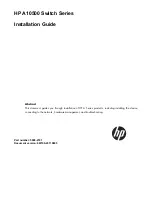
1-2
Cisco ASA Series CLI Configuration Guide
Chapter 1 Configuring IPsec and ISAKMP
Information About Tunneling, IPsec, and ISAKMP
The ASA functions as a bidirectional tunnel endpoint. It can receive plain packets from the private
network, encapsulate them, create a tunnel, and send them to the other end of the tunnel where they are
unencapsulated and sent to their final destination. It can also receive encapsulated packets from the
public network, unencapsulate them, and send them to their final destination on the private network.
IPsec Overview
The ASA uses IPsec for LAN-to-LAN VPN connections and provides the option of using IPsec for
client-to-LAN VPN connections. In IPsec terminology, a
peer
is a remote-access client or another secure
gateway. For both connection types, the ASA supports only Cisco peers. Because we adhere to VPN
industry standards, ASAs can work with other vendors' peers; however, we do not support them.
During tunnel establishment, the two peers negotiate security associations that govern authentication,
encryption, encapsulation, and key management. These negotiations involve two phases: first, to
establish the tunnel (the IKE SA) and second, to govern traffic within the tunnel (the IPsec SA).
A LAN-to-LAN VPN connects networks in different geographic locations. In IPsec LAN-to-LAN
connections, the ASA can function as initiator or responder. In IPsec client-to-LAN connections, the
ASA functions only as responder. Initiators propose SAs; responders accept, reject, or make
counter-proposals—all in accordance with configured SA parameters. To establish a connection, both
entities must agree on the SAs.
Configuration for site to site tasks is performed in both single context mode and multiple context mode.
Note
Multiple context mode only applies to IKEv2 and IKEv1 site to site and does not apply to AnyConnect,
clientless SSL VPN, the legacy Cisco VPN client, the Apple native VPN client, the Microsoft native
VPN client, or cTCP for IKEv1 IPsec.
ISAKMP and IKE Overview
ISAKMP is the negotiation protocol that lets two hosts agree on how to build an IPsec security
association (SA). It provides a common framework for agreeing on the format of SA attributes. This
security association includes negotiating with the peer about the SA and modifying or deleting the SA.
ISAKMP separates negotiation into two phases: Phase 1 and Phase 2. Phase 1 creates the first tunnel,
which protects later ISAKMP negotiation messages. Phase 2 creates the tunnel that protects data.
IKE uses ISAKMP to set up the SA for IPsec to use. IKE creates the cryptographic keys used to
authenticate peers.
The ASA supports IKEv1 for connections from the legacy Cisco VPN client, and IKEv2 for the
AnyConnect VPN client.
To set the terms of the ISAKMP negotiations, you create an IKE policy, which includes the following:
•
The authentication type required of the IKEv1 peer, either RSA signature using certificates or
preshared key (PSK).
•
An encryption method to protect the data and ensure privacy.
•
A Hashed Message Authentication Codes (HMAC) method to ensure the identity of the sender, and
to ensure that the message has not been modified in transit.
•
A Diffie-Hellman group to determine the strength of the encryption-key-determination algorithm.
The ASA uses this algorithm to derive the encryption and hash keys.
Summary of Contents for 5505 - ASA Firewall Edition Bundle
Page 28: ...Glossary GL 24 Cisco ASA Series CLI Configuration Guide ...
Page 61: ...P A R T 1 Getting Started with the ASA ...
Page 62: ......
Page 219: ...P A R T 2 Configuring High Availability and Scalability ...
Page 220: ......
Page 403: ...P A R T 2 Configuring Interfaces ...
Page 404: ......
Page 499: ...P A R T 2 Configuring Basic Settings ...
Page 500: ......
Page 533: ...P A R T 2 Configuring Objects and Access Lists ...
Page 534: ......
Page 601: ...P A R T 2 Configuring IP Routing ...
Page 602: ......
Page 745: ...P A R T 2 Configuring Network Address Translation ...
Page 746: ......
Page 845: ...P A R T 2 Configuring AAA Servers and the Local Database ...
Page 846: ......
Page 981: ...P A R T 2 Configuring Access Control ...
Page 982: ......
Page 1061: ...P A R T 2 Configuring Service Policies Using the Modular Policy Framework ...
Page 1062: ......
Page 1093: ...P A R T 2 Configuring Application Inspection ...
Page 1094: ......
Page 1191: ...P A R T 2 Configuring Unified Communications ...
Page 1192: ......
Page 1333: ...P A R T 2 Configuring Connection Settings and QoS ...
Page 1334: ......
Page 1379: ...P A R T 2 Configuring Advanced Network Protection ...
Page 1380: ......
Page 1475: ...P A R T 2 Configuring Modules ...
Page 1476: ......
Page 1549: ...P A R T 2 Configuring VPN ...
Page 1550: ......
Page 1965: ...P A R T 2 Configuring Logging SNMP and Smart Call Home ...
Page 1966: ......
Page 2059: ...P A R T 2 System Administration ...
Page 2060: ......
Page 2098: ...1 8 Cisco ASA Series CLI Configuration Guide Chapter 1 Troubleshooting Viewing the Coredump ...
Page 2099: ...P A R T 2 Reference ...
Page 2100: ......











































